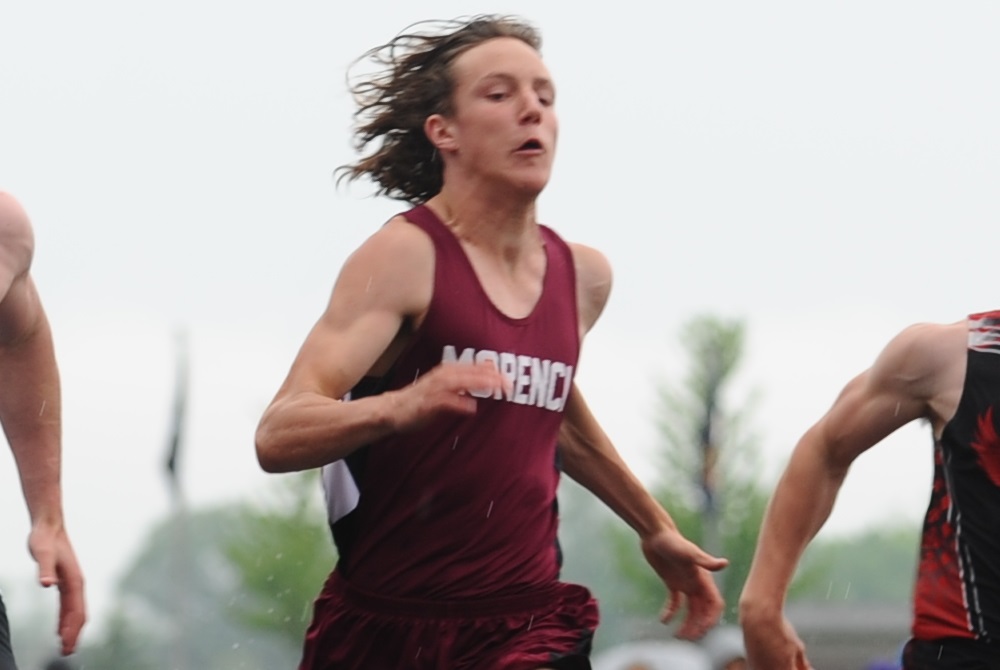
Morenci Rallies to Support 3-Sport Standout
By
Doug Donnelly
Special for MHSAA.com
March 22, 2021
MORENCI – It would have been easy for Rodney Zimmerman to take a night off and no one would have thought twice.
 But the three-sport athlete at Morenci High School in Lenawee County wouldn’t even consider it. Even while his mom was going through cancer treatments, battling COVID-19 and pneumonia, Zimmerman hit the weight room every morning, showed up for practice every afternoon and, now, has taken a step toward his dream of becoming a college athlete.
But the three-sport athlete at Morenci High School in Lenawee County wouldn’t even consider it. Even while his mom was going through cancer treatments, battling COVID-19 and pneumonia, Zimmerman hit the weight room every morning, showed up for practice every afternoon and, now, has taken a step toward his dream of becoming a college athlete.
Zimmerman committed this week to Saginaw Valley State University to run track.
“He’s just one of those kids that everyone rallies around,” said Morenci track and football coach Stefan Wilkinson. “He works really hard at everything he does. He goes all out, every time he’s on the court or field or track. He’s a very humble kid.”
Outside of his own community, few people were aware that his mother was going through cancer treatments in the fall, causing her to miss some of his games. Morenci rallied around the quiet senior.
“Everyone knew what was going on,” Zimmerman said, reluctantly. “Morenci is a small town. The parents and coaches were great to me. They would cook meals for us. That was really nice.
“Sports is a way for me to put that out of my mind,” he said. “I just go out and play the game. It is hard, but you have to do it. Football became my escape from all of that. That really helped. It wasn’t too hard to focus. Well, it was, but I just had to do it. I wanted to keep playing.”
Sports has been a part of his life since grade school. He grew up near Waldron in Hillsdale County and attended Pittsford until seventh grade when he moved schools and started going to Morenci. It was a good fit for him and the community.
His first interest was basketball, but he decided to pick up other sports as well.
“At first when I came here, I just played basketball, but I eventually picked up football and then track,” he said. “The coaches always told me it was good to play all of the other sports.”
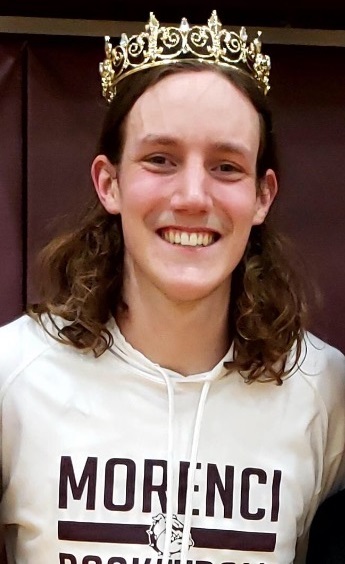 He’s a familiar face at Morenci events because he stands out in three sports. He also wears a signature headband.
He’s a familiar face at Morenci events because he stands out in three sports. He also wears a signature headband.
Zimmerman was a running back for the Morenci football team in the fall, is a point guard for the Bulldogs basketball team as they head into next week’s Division 3 postseason, and he can’t wait to return to the track this spring. He’s a sprinter and a good one.
As a sophomore, Zimmerman finished second at the Tri-County Conference meet in both the 100 and 200 meters. At the Division 4 Finals, he placed fourth in the 100 and helped the Bulldogs 400 relay team place fourth as well. He also qualified in the 200.
He likes how track is somewhat of an individual sport.
“I like all of the sports, but I like that in track I have total control,” he said. “The only one responsible for your performance is you. It’s all up to you.”
He missed his junior year of track due to the season being canceled because of COVID-19.
“I was really disappointed that I missed my junior season because that’s a big season for recruitment,” he said. “I was thinking we were going to still have a season. I was working out and getting ready, then it was canceled. I was still lifting and trying to stay ready.”
He has goals for this season.
“I want to go to state again, and I want to be in the top three in my events,” he said.
He committed to Saginaw Valley State, a Division II college, after visiting the campus and finding out the Cardinals were able to give some scholarship money.
“They made the best offer,” he said. “I’ve always wanted to go to college. That’s been my plan. I want to do something in business, maybe own my own gym.”
College is still a while away. Right now, there is the District tournament looming for Morenci, then track season. His mother had a scan recently to find out where she stands with cancer.
For now, he’s happy to have her in the stands, watching him compete. The community continues to rally around him. His teammates do, too. During football season, Zimmerman and other players wore green on their shoes or wrist – a lime green ribbon promotes Lymphoma cancer awareness.
“It’s nice to have her watching again,” he said. “She missed some football games. She just had a pet scan last week to see if it is all gone. We are hoping for the best.”
 Doug Donnelly has served as a sports and news reporter and city editor over 25 years, writing for the Daily Chief-Union in Upper Sandusky, Ohio from 1992-1995, the Monroe Evening News from 1995-2012 and the Adrian Daily Telegram since 2013. He's also written a book on high school basketball in Monroe County and compiles record books for various schools in southeast Michigan. E-mail him at [email protected] with story ideas for Jackson, Washtenaw, Hillsdale, Lenawee and Monroe counties.
Doug Donnelly has served as a sports and news reporter and city editor over 25 years, writing for the Daily Chief-Union in Upper Sandusky, Ohio from 1992-1995, the Monroe Evening News from 1995-2012 and the Adrian Daily Telegram since 2013. He's also written a book on high school basketball in Monroe County and compiles record books for various schools in southeast Michigan. E-mail him at [email protected] with story ideas for Jackson, Washtenaw, Hillsdale, Lenawee and Monroe counties.
PHOTOS: (Top) Morenci's Rodney Zimmerman sprints toward the finish of a preliminary race during the 2019 Track & Field Finals. (Middle) Zimmeran was named this winter's Homecoming king. (Top photo by RunMichigan.com; middle photo submitted.)
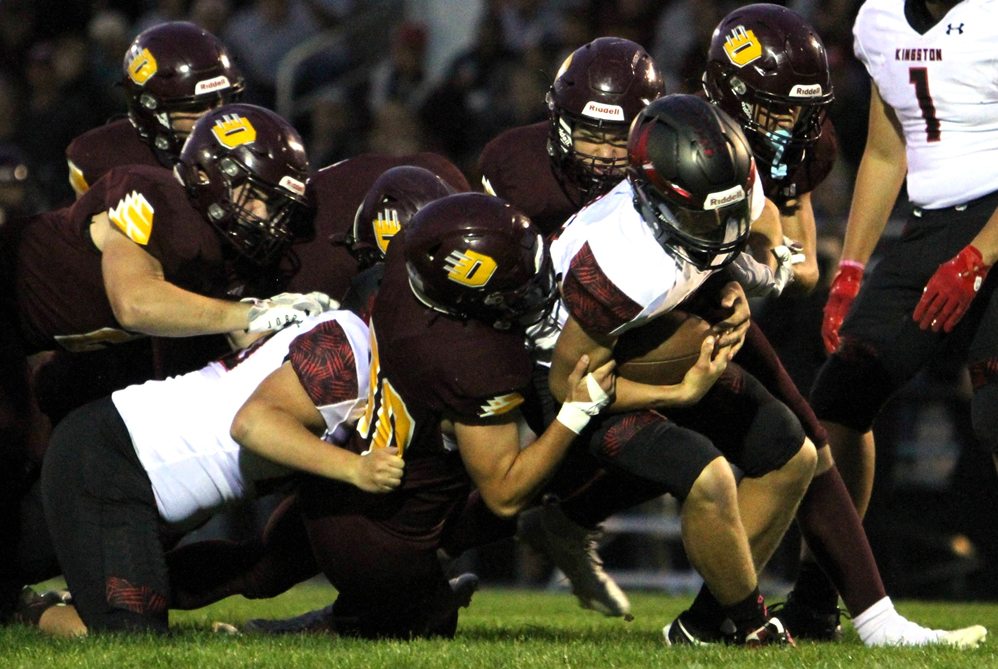
With Seasoned Seniors in Lead, Deckerville Set to Begin Another Title Pursuit
By
Paul Costanzo
Special for MHSAA.com
October 30, 2024
Preston Holman was an eighth grader when his family moved to Deckerville from the west side of the state, but it didn’t take long for him to realize how much football meant to the community.
 “Instantly, it was all clear to me that Deckerville was a powerhouse program around here, and if you’re going to play for them and Coach (Bill) Brown, you needed to be the best version of yourself,” said Holman, now a senior and all-state two-way lineman for the Eagles. “It was really cool. I remember my eighth-grade year, Deckerville lost to Mayville on Homecoming. I remember how upset the players were. I could tell in the atmosphere that Deckerville does not like to lose. But it was really cool to see how the community supported the program.”
“Instantly, it was all clear to me that Deckerville was a powerhouse program around here, and if you’re going to play for them and Coach (Bill) Brown, you needed to be the best version of yourself,” said Holman, now a senior and all-state two-way lineman for the Eagles. “It was really cool. I remember my eighth-grade year, Deckerville lost to Mayville on Homecoming. I remember how upset the players were. I could tell in the atmosphere that Deckerville does not like to lose. But it was really cool to see how the community supported the program.”
Holman and the Eagles have set themselves up to have that support through the 8-Player Division 1 Semifinals, should they keep winning, as the highest-rated team by playoff points in the bracket.
Deckerville, which finished a 9-0 regular season with a win over previous No. 1 Alcona in Week 9, will open the postseason at home Friday night against Bay City All Saints.
“It’s been great,” senior quarterback Hunter Garza said. “We’ve been taking it one game at a time and preparing all season for this, and I think the hard work is showing and paying off. This started three years ago, when we were all sophomores and freshmen, and the hard work is all paying off.”
When Garza and Holman were sophomores, they were part of a core group in that class who were playing key roles on the varsity. That group went 7-4 and won a playoff game in 2022, and Brown was starting to see the potential for something special in the future.
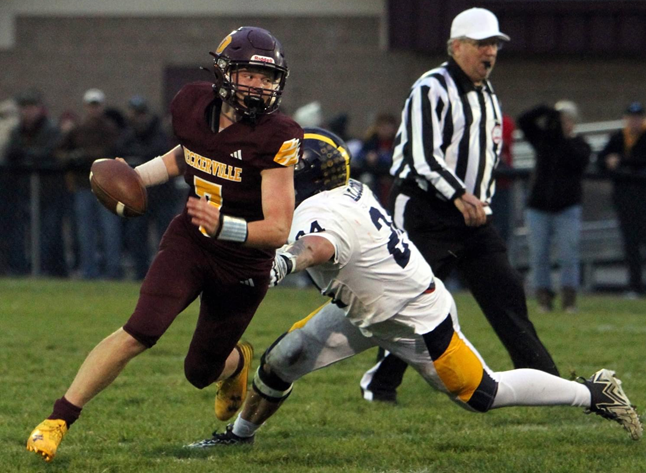 A run to an 8-Player Division 2 Semifinal the next year proved him right.
A run to an 8-Player Division 2 Semifinal the next year proved him right.
“We have six kids that started when they were sophomores that are now seniors, and last year, our defense was one freshman, three sophomores and four juniors, so our whole defense is back,” Brown said. “So we knew we had a lot of potential there. We knew we had something going on, even back then. We knew when they were sophomores, even though they were pretty young. The next year, we got halfway through the season, and they were juniors that were starting to play like seniors.”
Knowing what he had coming back, and what a Deckerville crowd could bring during a playoff run, Brown set out to build a schedule that could guarantee the Eagles homefield advantage through the first three weeks of the postseason. That meant scheduling All Saints in Week 1 and Alcona in Week 9. Even had the Eagles lost those games, the benefit of playing a tougher schedule would have been a net positive. Of course, they won them, getting the best of both worlds.
“We play some tough competition in our conference,” Brown said. “But to get to 9-0, that’s pretty special.”
The Eagles outscored opponents, on average, 49-14 on their way to the program’s first unbeaten season since 2019, and fifth in Brown’s 32 years as head coach.
“I think we’ve played very good defense,” Brown said. “Last week (a 50-42 win against Alcona) was tough, but we were playing one of the best teams in the state. Sometimes you have to outscore someone. I think, defensively, we match up and are able to defend a lot of people. Then, being able to turn around and Hunter Garza is having a great year at quarterback – he can run, and he can throw – so I think we’re a little more diverse offensively.”
Garza has rushed for 1,134 yards and 21 touchdowns on 104 carries this season, leading an Eagles’ offense that is averaging 304.9 yards per game on the ground. Senior Parker Merriman had added 859 yards and 11 TDs.
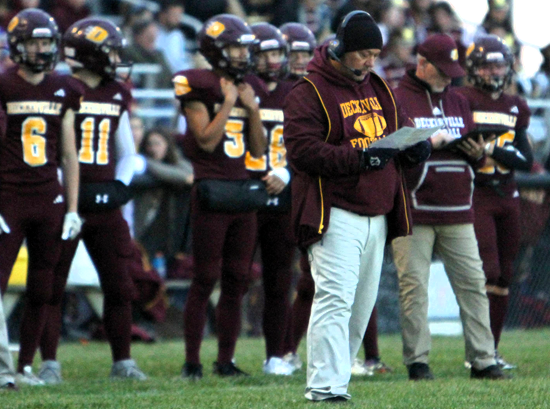 Garza also has thrown for 747 yards and nine touchdowns on just 76 pass attempts.
Garza also has thrown for 747 yards and nine touchdowns on just 76 pass attempts.
Defensively, the Eagles specialize in getting teams out of sync, as they have recorded 42 tackles for loss as a team, led by Holman’s 17. He also has nine sacks, while sophomore Brandon Halowitz leads the team with 83 tackles, including 13 for loss and five sacks.
Being a defensive stalwart is nothing new for the Eagles. When they joined the 8-player ranks in 2012, they brought a smashmouth style to what had been a wide-open division, and won a Finals title. The score of that championship game against Bellaire: 14-12.
They’ve made the postseason in each of the 12 years since, advancing to Finals in 2016 and 2017.
“Our goal each year is to win the state championship,” Brown said. “Maybe those seem like lofty goals for many, but I think you have to do that. And, as it goes, right now we’re peaking at it. Last year, nobody would have thought we were going to make a run and get to the Semifinal. I would say the expectations are high for us, and I think that gives our team the drive to always be better than the team that did it before.”
Managing to chase those goals while remaining grounded in the day-to-day work necessary to reach them can be tough. But with senior leaders like Garza and Holman, Brown is confident his team will stay on the right path.
“Deckerville has such a good winning tradition, that it does put a lot of pressure on us, but Coach always says, ‘Just because you’re Deckerville, you’re not guaranteed to make the playoffs,’” Garza said. “Just because you wear the D, doesn’t mean you’re going to make a run in the playoffs. You gotta go out and work for it. You have to go out and win it.”
 Paul Costanzo served as a sportswriter at The Port Huron Times Herald from 2006-15, including three years as lead sportswriter, and prior to that as sports editor at the Hillsdale Daily News from 2005-06. He can be reached at [email protected] with story ideas for Genesee, Lapeer, St. Clair, Sanilac, Huron, Tuscola, Saginaw, Bay, Arenac, Midland and Gladwin counties.
Paul Costanzo served as a sportswriter at The Port Huron Times Herald from 2006-15, including three years as lead sportswriter, and prior to that as sports editor at the Hillsdale Daily News from 2005-06. He can be reached at [email protected] with story ideas for Genesee, Lapeer, St. Clair, Sanilac, Huron, Tuscola, Saginaw, Bay, Arenac, Midland and Gladwin counties.
PHOTOS (Top) The Deckerville defense converges on a Kingston ball carrier during this season’s 44-0 victory. (Middle) Hunter Garza eludes an Alcona defender last week. (Below) Eagles coach Bill Brown, in headset, checks his chart on the sideline. (Photos by Mike Gallagher/Saranac County News.)

